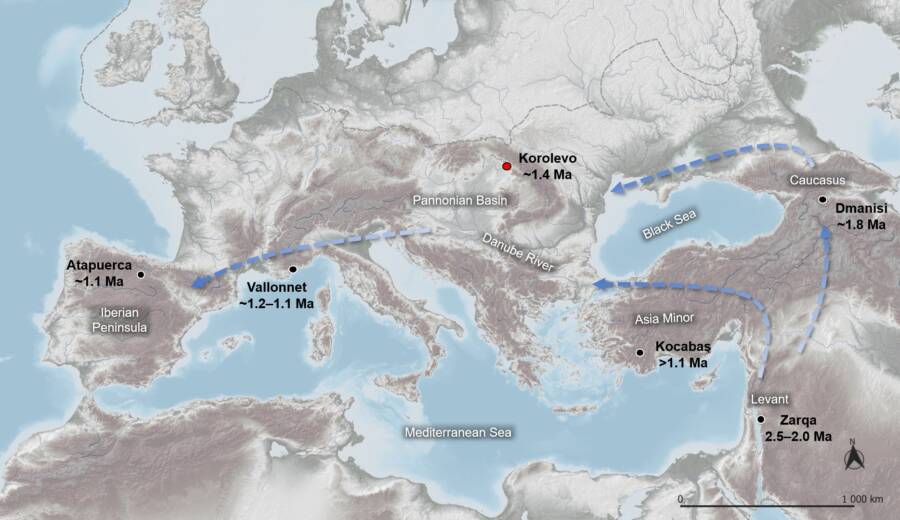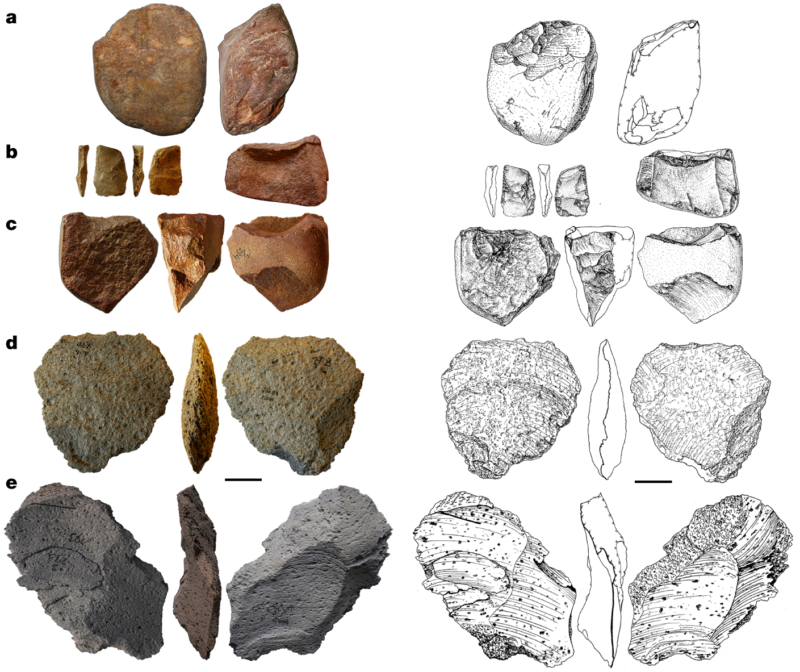After analyzing stone tools found at the Korolevo site in western Ukraine, researchers concluded that Homo erectus settled in the area roughly 1.4 million years ago.

CAS Prague Institute of ArchaeologyA researcher stands at Korolevo, the site of the oldest known European settlement.
Archaeologists have discovered the oldest known European settlement in western Ukraine. Approximately 1.4 million years ago, Homo erectus inhabited the region near Korolevo, leaving behind stone tools.
A recent study of these tools revealed that hominins expanded into Europe hundreds of thousands of years earlier than previously suspected. The study was made possible by technology that holds incredible promise for analyzing future archaeological discoveries.
Discovering The Oldest European Settlement

CAS Prague Institute of ArchaeologyA researcher holds a stone tool in Korolevo.
The discovery of the stone tools at Korolevo dates back to the 1970s, when researchers near the Tysa River in the Carpathian foothills discovered the artifacts. At the time, technology had not developed enough to accurately date them.
Just recently, efforts by 10 research institutions across the globe determined the stone tools were 1.4 million years old. Research methods involved analyzing the age of sediment layers containing the stone tools — a tactic that gives insight into how early humans spread into Europe during the interglacial period.
Scientists believe that the tools were created by Homo erectus, a species of early human that first appeared 2 million years ago and went extinct roughly 100,000 years ago. Physically, Homo erectus was similar to Homo sapiens, although they possessed a smaller brain.
“No bones were found at Korolevo, only stone tools. But the age suggests that Homo erectus was the only possible human species at the time. We know very little about our earliest ancestors. They used stone tools for butchery and probably used fire,” Roman Garba, Czech Academy of Sciences archaeologist and lead author of the study published in the journal Nature, told Reuters.
This finding is significant for understanding how hominins first came to Europe. Previously, the oldest known settlement in Europe was Atapuerca in Spain, but Korolevo predates Atapuerca by 200,000 to 300,000 years. With this discovery, researchers are confident that hominins first traveled into Europe from the east.

CAS Prague Institute of ArchaeologyA map showing the migration of hominins through Europe.
“Based on a climate model and field pollen data, we have identified three possible interglacial warm periods when the first hominins could have reached Korolevo following most likely the Danube River migration corridor,” Garba added.
New Dating Techniques Show Promise
Not only did the discovery at Korolevo reveal exciting details about early hominid migration, but it also used a new dating technique that could change the field of archaeology.
First, researchers analyzed the tools using accelerator mass spectrometry (AMS).
“At the Korolevo site,” Garba explained in the CAS Prague Institute of Archaeology’s press release, “we specifically measured the concentrations of cosmogenic nuclides beryllium-10 and aluminium-26 which have different half-lives… These nuclides accumulate in the quartz grains when the rock is at the surface due to cosmogenic radiation from the space, but they begin to decay when they become buried in the ground.”
“The ratio of the two varies according to how long the clasts were buried beneath the ground surface,” Garba continued. “This allows us to calculate their age since burial.”

CAS Prague Institute of ArchaeologyThe stone tools found at the site.
Then, researchers John Jansen from the CAS Institute of Geophysics and Mads Knudsen from Aarhus University in Denmark implemented a new mathematical modeling technique, known as P-PINI, to accurately date the stone tools.
“I expect our new dating approach will have a major impact on archaeology because it can be applied to sedimentary deposits that are highly fragmented, meaning there are lots of erosional gaps,” Jansen noted in the press release.
Thanks to this technique, archaeologists have now filled in yet another piece in the puzzle of early human history.
After reading about the oldest known European settlement, discover the stories of nine of the oldest structures in the world. Then, read about the Neanderthals, a hominin species that disappeared 40,000 years ago.





